Page 13 of 251
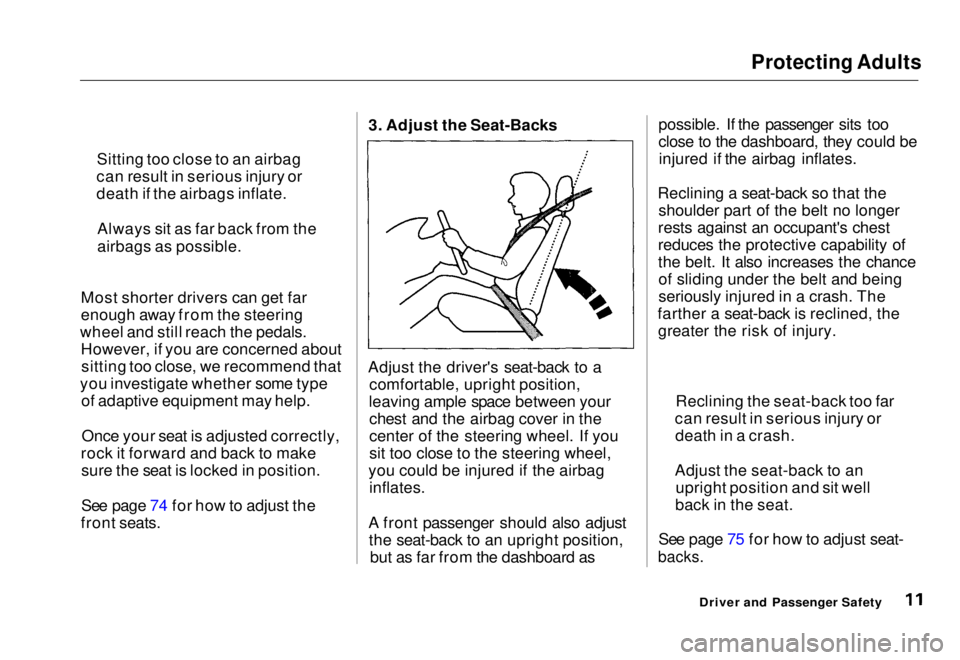
Protecting Adults
Most shorter drivers can get far
enough away from the steering
wheel and still reach the pedals. However, if you are concerned aboutsitting too close, we recommend that
you investigate whether some type of adaptive equipment may help.
Once your seat is adjusted correctly,
rock it forward and back to make sure the seat is locked in position.
See page 74 for how to adjust the
front seats. 3. Adjust the Seat-Backs
Adjust the driver's seat-back to a comfortable, upright position,
leaving ample space between your chest and the airbag cover in the
center of the steering wheel. If you
sit too close to the steering wheel,
you could be injured if the airbag inflates.
A front passenger should also adjust the seat-back to an upright position, but as far from the dashboard as possible. If the passenger sits too
close to the dashboard, they could be
injured if the airbag inflates.
Reclining a seat-back so that the shoulder part of the belt no longer
rests against an occupant's chest
reduces the protective capability of
the belt. It also increases the chance of sliding under the belt and being
seriously injured in a crash. The
farther a seat-back is reclined, the greater the risk of injury.
See page 75 for how to adjust seat-
backs.
Driver and Passenger Safety
Sitting too close to an airbag
can result in serious injury or
death if the airbags inflate.
Always sit as far back from the
airbags as possible.
Reclining the seat-back too far
can result in serious injury or death in a crash.
Adjust the seat-back to an upright position and sit well
back in the seat.Main Menu Table of Contents s t
Page 18 of 251
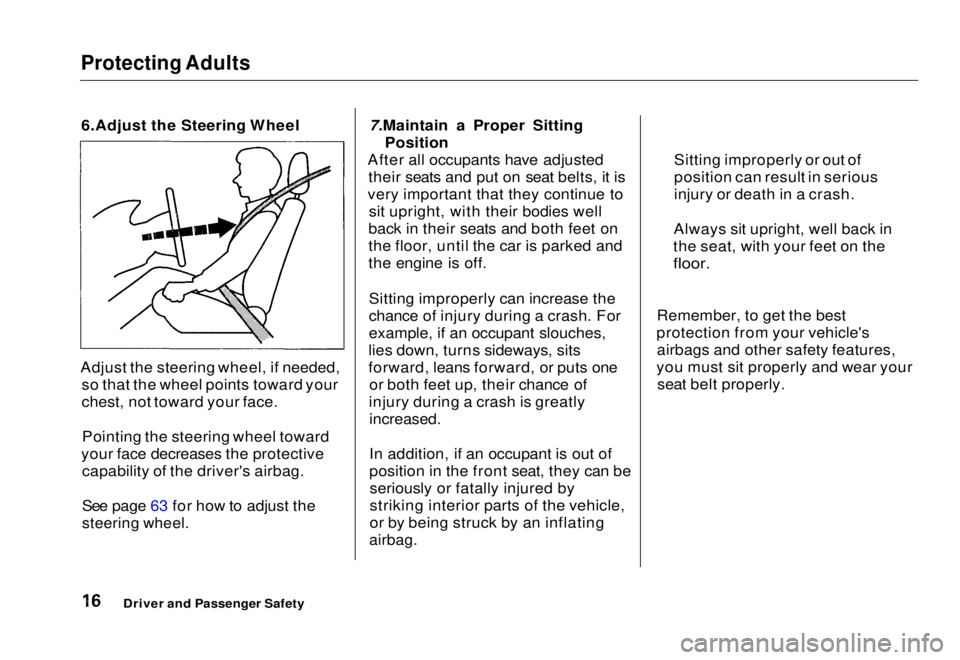
Protecting Adults
6.Adjust the Steering Wheel
Adjust the steering wheel, if needed, so that the wheel points toward your
chest, not toward your face.
Pointing the steering wheel toward
your face decreases the protective capability of the driver's airbag.
See page 63 for how to adjust the
steering wheel.
7.Maintain a Proper Sitting
Position
After all occupants have adjusted their seats and put on seat belts, it is
very important that they continue to sit upright, with their bodies well
back in their seats and both feet on
the floor, until the car is parked and
the engine is off.
Sitting improperly can increase the
chance of injury during a crash. For
example, if an occupant slouches,
lies down, turns sideways, sits
forward, leans forward, or puts one or both feet up, their chance of
injury during a crash is greatly
increased.
In addition, if an occupant is out of
position in the front seat, they can beseriously or fatally injured by
striking interior parts of the vehicle,
or by being struck by an inflating
airbag.
Remember, to get the best
protection from your vehicle's airbags and other safety features,
you must sit properly and wear your seat belt properly.
Driver and Passenger Safety Sitting improperly or out of
position can result in serious
injury or death in a crash.
Always sit upright, well back in
the seat, with your feet on the
floor.Main Menu Table of Contents s t
Page 19 of 251
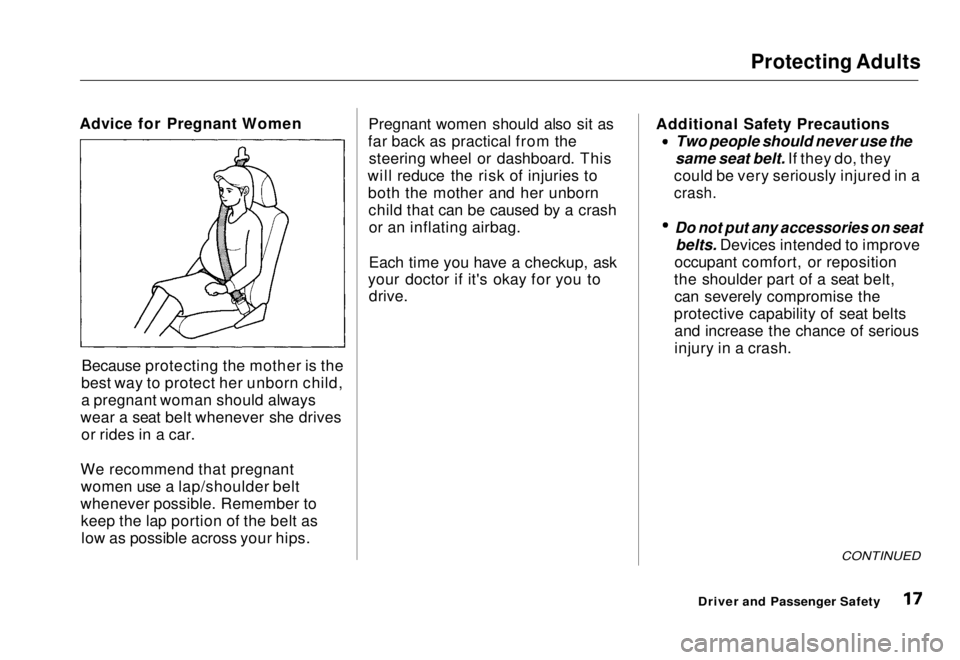
Protecting Adults
Advice for Pregnant Women
Because protecting the mother is the
best way to protect her unborn child,
a pregnant woman should always
wear a seat belt whenever she drives or rides in a car.
We recommend that pregnant women use a lap/shoulder belt
whenever possible. Remember to keep the lap portion of the belt aslow as possible across your hips. Pregnant women should also sit as
far back as practical from the steering wheel or dashboard. This
will reduce the risk of injuries to both the mother and her unbornchild that can be caused by a crashor an inflating airbag.
Each time you have a checkup, ask
your doctor if it's okay for you to drive. Additional Safety Precautions
Two people should never use the
same seat belt. If they do, they
could be very seriously injured in a
crash.
Do not put any accessories on seat
belts. Devices intended to improve
occupant comfort, or reposition
the shoulder part of a seat belt, can severely compromise the
protective capability of seat belts and increase the chance of serious
injury in a crash.
CONTINUED
Driver and Passenger SafetyMain Menu Table of Contents s t
Page 20 of 251
Protecting Adults
Do not place hard or sharp objects
between yourself and an airbag.
Carrying hard or sharp objects on
your lap, or driving with a pipe or other sharp object in your mouth,
can result in injuries if your
airbags inflate.
Keep your hands and arms away
from the airbag covers.
If your hands or arms are close to
the SRS covers in the center of the steering wheel and on top of the
dashboard, they could be injured if
the airbags inflate.
Driver and Passenger SafetyMain Menu Table of Contents s t
Page 22 of 251
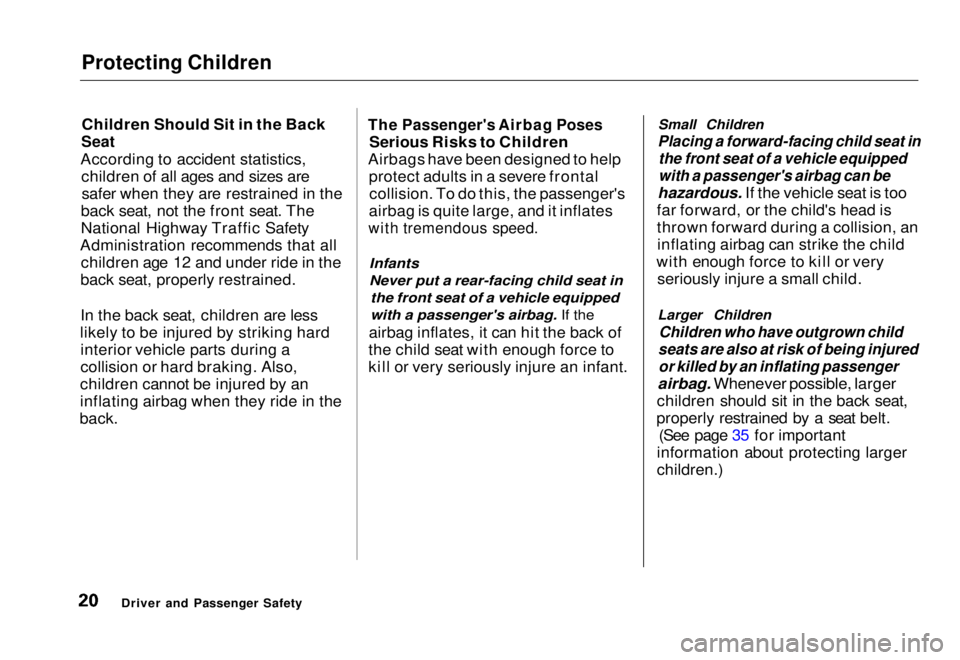
Protecting Children
Children Should Sit in the Back
Seat
According to accident statistics, children of all ages and sizes aresafer when they are restrained in the
back seat, not the front seat. The
National Highway Traffic Safety
Administration recommends that all children age 12 and under ride in the
back seat, properly restrained.
In the back seat, children are less
likely to be injured by striking hard interior vehicle parts during a
collision or hard braking. Also,
children cannot be injured by an
inflating airbag when they ride in the
back.
The Passenger's Airbag Poses
Serious Risks to Children
Airbags have been designed to help protect adults in a severe frontalcollision. To do this, the passenger's
airbag is quite large, and it inflates
with tremendous speed.
Infants
Never put a rear-facing child seat in the front seat of a vehicle equipped
with a passenger's airbag. If the
airbag inflates, it can hit the back of
the child seat with enough force to
kill or very seriously injure an infant. Small Children
Placing a forward-facing child seat in the front seat of a vehicle equipped
with a passenger's airbag can be
hazardous. If the vehicle seat is too
far forward, or the child's head is
thrown forward during a collision, an inflating airbag can strike the child
with enough force to kill or very seriously injure a small child.
Larger Children
Children who have outgrown child
seats are also at risk of being injured or killed by an inflating passenger
airbag. Whenever possible, larger
children should sit in the back seat,
properly restrained by a seat belt. (See page 35 for important
information about protecting larger
children.)
Driver and Passenger SafetyMain Menu Table of Contents s t
Page 23 of 251
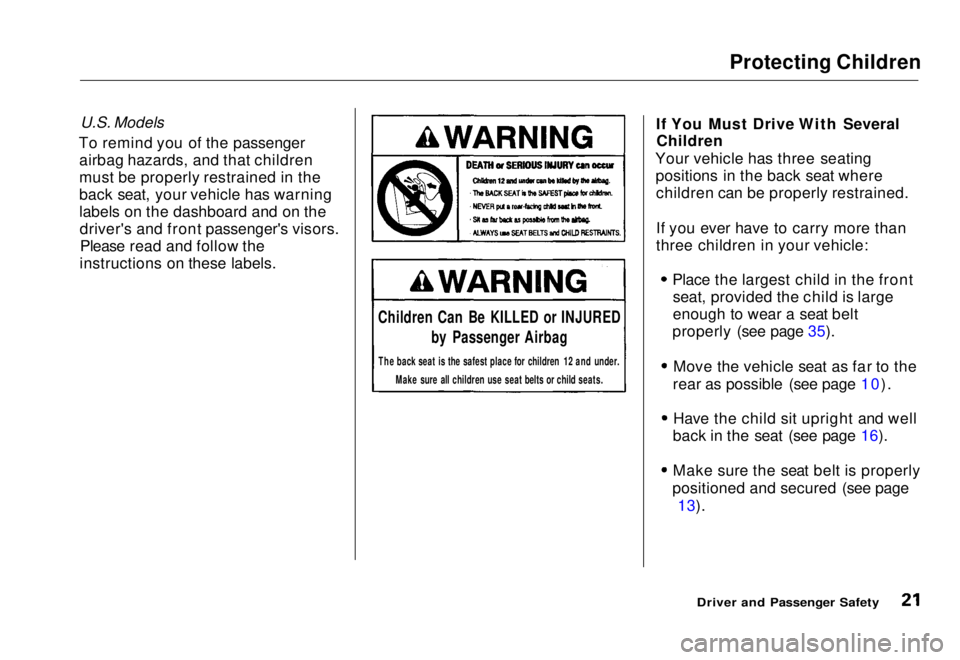
Protecting Children
U.S. Models
To remind you of the passenger airbag hazards, and that children
must be properly restrained in the
back seat, your vehicle has warning
labels on the dashboard and on thedriver's and front passenger's visors.Please read and follow the
instructions on these labels. If You Must Drive With Several
Children
Your vehicle has three seating positions in the back seat wherechildren can be properly restrained.
If you ever have to carry more than
three children in your vehicle:
Place the largest child in the frontseat, provided the child is large
enough to wear a seat belt
properly (see page 35).
Move the vehicle seat as far to the
rear as possible (see page 10).
Have the child sit upright and well
back in the seat (see page 16). Make sure the seat belt is properly
positioned and secured (see page 13).
Driver and Passenger Safety
Children Can Be KILLED or INJURED
by Passenger Airbag
The back seat is the safest place for children 12 and under. Make sure all children use seat belts or child seats.Main Menu Table of Contents s t
Page 24 of 251
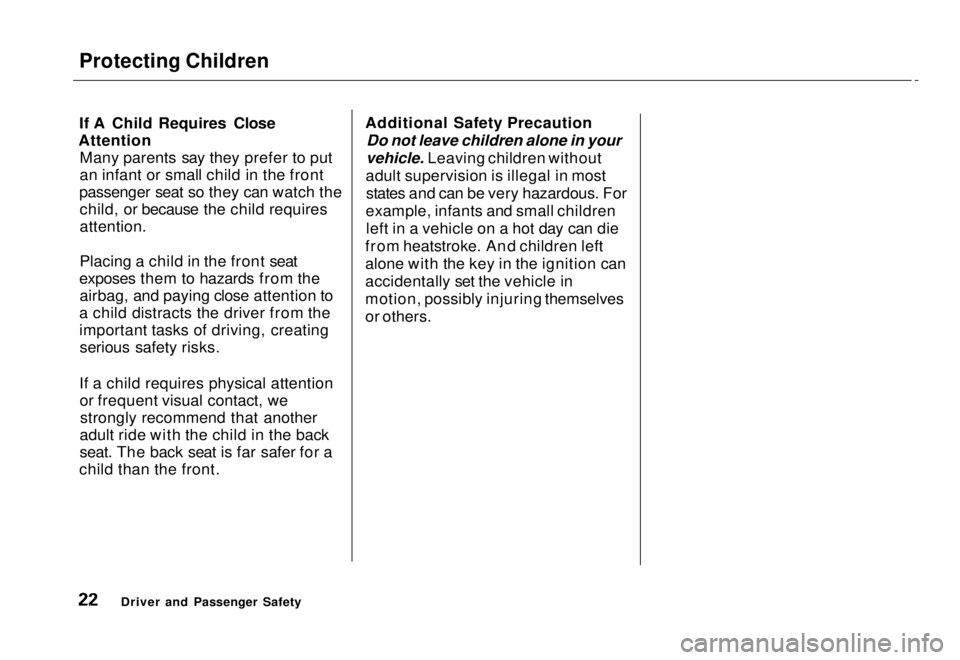
Protecting Children
If A Child Requires Close
Attention Many parents say they prefer to put
an infant or small child in the front
passenger seat so they can watch the child, or because the child requires
attention.
Placing a child in the front seat
exposes them to hazards from the airbag, and paying close attention to
a child distracts the driver from the
important tasks of driving, creating serious safety risks.
If a child requires physical attention or frequent visual contact, westrongly recommend that another
adult ride with the child in the back
seat. The back seat is far safer for a
child than the front. Additional Safety Precaution
Do not leave children alone in your
vehicle. Leaving children without
adult supervision is illegal in most states and can be very hazardous. For
example, infants and small children left in a vehicle on a hot day can die
from heatstroke. And children left
alone with the key in the ignition can
accidentally set the vehicle in
motion, possibly injuring themselves
or others.
Driver and Passenger SafetyMain Menu Table of Contents s t
Page 27 of 251
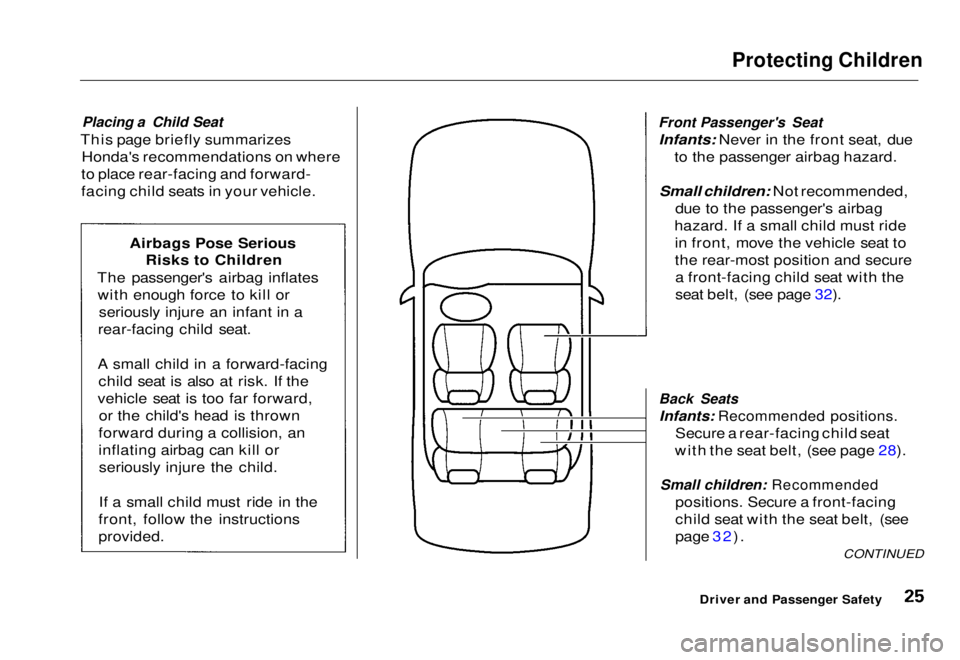
Protecting Children
Placing a Child Seat
This page briefly summarizes Honda's recommendations on where
to place rear-facing and forward-
facing child seats in your vehicle.
Front Passenger's Seat
Infants: Never in the front seat, due to the passenger airbag hazard.
Small children: Not recommended,
due to the passenger's airbag
hazard. If a small child must ride in front, move the vehicle seat to
the rear-most position and securea front-facing child seat with the
seat belt, (see page 32).
Back Seats
Infants: Recommended positions.
Secure a rear-facing child seat
with the seat belt, (see page 28).
Small children: Recommended
positions. Secure a front-facing
child seat with the seat belt, (see
page 32). CONTINUED
Driver and Passenger Safety
Airbags Pose Serious
Risks to Children
The passenger's airbag inflates with enough force to kill or seriously injure an infant in a
rear-facing child seat.
A small child in a forward-facing child seat is also at risk. If the
vehicle seat is too far forward, or the child's head is thrown
forward during a collision, an
inflating airbag can kill or seriously injure the child.
If a small child must ride in the
front, follow the instructions
provided.Main Menu Table of Contents s t